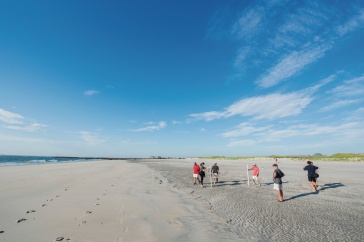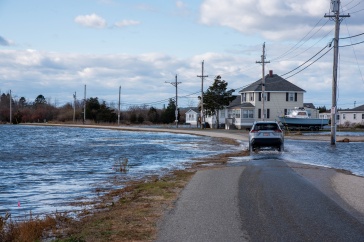
In 1992, Jamie Emery ’80, president of Emery & Garrett Groundwater Investigations (EGGI), was retained by the Virginia State Department of Corrections to identify new water sources for a prison in Culpeper County. The caveat: he first had to drill at a site a local dowser hired by the state had chosen. After poking around with his forked stick, the dowser placed his ear to the ground, told Emery he heard a subterranean river, and advised Emery to drill on the spot. “We got 10 gallons of water a minute,” recalls Emery — a less-than-optimal result. When the dowser suggested drilling 15 additional wells, the state instead chose to drill the first of several sites EGGI had identified using satellite imagery, geologic mapping, bedrock fracture fabric analysis and other scientific methods. That well produced 300 gallons of water a minute, and the state went on to hire EGGI for six additional projects. “That’s groundwater exploration using site-specific exploration methods,” Emery says. “It works.”
You could think of Emery and his team as scientific dowsers: Instead of sticks, they use high-tech tools like glacial mapping technology, geophysical survey techniques and groundwater modeling to unravel complex water resource problems. Since the company’s 1989 founding, EGGI has completed more than 1,500 projects for businesses and municipalities throughout the eastern United States, including federal agencies, universities, hospitals, municipal utilities, public water authorities, counties, states and Fortune 500 companies. Here in New Hampshire, the firm weighed in on the potential effects of the Northeast Energy Direct pipeline on groundwater resources as well as ongoing discussions about the impact of contaminant perfluorooctanoic acid on domestic and public water supplies. EGGI also pioneered a project for UNH and the town of Durham to augment existing groundwater supply that could “change the paradigm for how we use water in the future,” Emery says.
Small firm, big impact
Based in an unassuming building in Meredith not far from the shores of Lake Winnipesaukee, EGGI was founded by Emery and hydrogeologist Peter Garrett. The two met in the 1980s, when Garrett was working for the Maine Department of Environmental Protection cleaning up contaminated groundwater sites. He and Emery decided their new company would handle “clean” (i.e., groundwater exploration and development) and “dirty” (contaminated groundwater) water projects. The firm now works exclusively on clean groundwater projects and has built a reputation for superb scientific expertise that Emery credits to the firm’s collegial atmosphere. “Our projects are hard and often very complicated,” he says. “It takes everyone’s skill sets and talents, working together, to succeed. We help each other out to serve our clients in the best ways possible.”
“Our work requires skills in all of the sciences: physics, chemistry, geology and biology. UNH has a great pool of people to draw from for our industry.”
Perhaps not coincidentally, seven of the firm’s employees are former Wildcats: Emery; vice presidents John Brooks ’90 and Daniel Tinkham ’86; senior project managers Jeff Marts ’96 and Peter Foster ’00; and field supervisors Ryan Allen ’00 and Michael O’Brien ’05. “Our work requires skills in all of the sciences: physics, chemistry, geology and biology,” says Tinkham. “UNH has a great pool of people to draw from for our industry.”
Nearly all of those Wildcats were involved when the firm took on a recent water development/management project for the university and the town of Durham that could become a national template for water sustainability.
Durham’s water demand is highest when its primary sources of water, the Lamprey and Oyster Rivers, are at their lowest flows: during the fall, when students return to campus. After years of testing and monitoring, EGGI determined that a new groundwater supply could be created by transferring water from the Lamprey into the adjacent Spruce Hole Aquifer when the river is at its peak flow — a process called artificial recharge. Excess water is pumped into underground basins in the aquifer, where it’s treated and filtered naturally by the soil and sand and gravel deposits. The first artificial recharge project to be approved in New Hampshire, the process creates a sustainable water resource and eases concerns about droughts — like the one New Hampshire is currently in. “It’s a perfect solution for a coastal area, where water supply demands are continually increasing” says Emery. “Testing determined that the introduction of surface water doesn’t contaminate groundwater and, at the same time, we’re protecting wetlands and the environment.”
EGGI teamed with the College of Engineering and Physical Sciences to help prove the project’s viability. Tom Ballestero, a hydrogeologist and director of the UNH Stormwater Center, provided background data on the Spruce Hole Aquifer’s hydrogeology and its potential as a groundwater source; Matthew Davis, associate professor of earth sciences, was hired by EGGI to help determine how the aquifer was affected by new groundwater wells; the department of civil and environmental engineering’s Robin Collins analyzed water samples and conducted field tests in the aquifer; and Wesley East, chief operator of UNH’s water treatment plant, provided the water quality analysis that supported the project.
Emery is often asked to share his expertise with government and public policy officials. Last year, he addressed the World Bank and Pentagon staff on critical water supply, protection and conservation issues. He’s also discussed water security with the National Security Agency and groundwater development opportunities with the U.S. Army and led a countrywide groundwater investigation for the Dominican Republic. Still, he’s matter-of-fact about his work. “You’re only as good as your last project,” he says. “We have one of the best, most experienced groundwater exploration groups in the country. The fact that many of us have worked together for 25 years or so provides great benefits to all of the clients we serve.”
Originally published in UNH Magazine Winter 2017 Issue
-
Written By:
Debbie Kane | Freelance Writer



















































